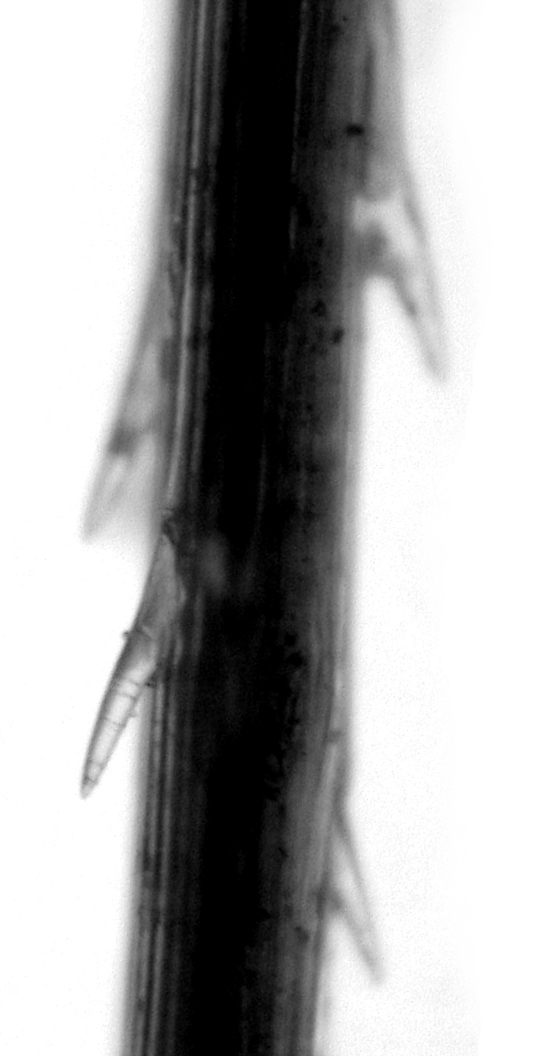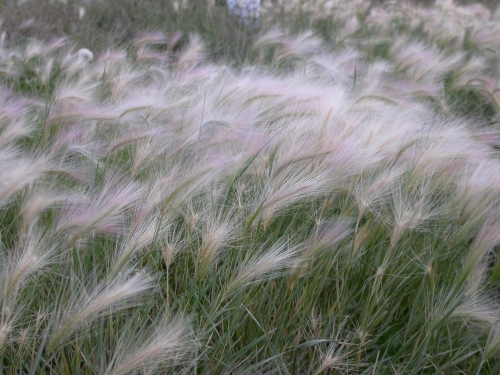
 | : Foxtail barley: a threat to your dog |
by D. Smith, R. Shearer and C. Fisher
Foxtail barley (Hordeum jubatum L.) is a common species of grass found across Canada. Awns or large bristles attached to the seeds of the plant are a potential hazard for any animal including your dog. The awns facilitate the dispersal of seeds to sites that may be suitable for germination and establishment.
The awns are capable of invading the body of your dog through the mouth, anus, feet ears, or through any point on the body surface. Once the awns penetrate the skin they move in one direction because of the orientation of minute barbs attached to each larger bristle (e.g., similar to the barbs on the larger quills of a porcupine). Awns can travel throughout the body in the blood. The awns are capable of killing your dog and as some autopsies reveal, the awns may accumulate in the heart. Awns can also penetrate the ears and become embedded in the eardrum. Similarly, awns can enter through the nose and become lodged in the nasal passageway. Awns entering through the mouth can become lodged in the lungs, spinal cord and/or chest cavity. Secondary effects from infections are also a problem. Partially penetrated awns that are visible should be removed immediately, preferably by a trained professional. You should contact your veterinarian for a list of possible symptoms and treatment methods.
What is foxtail barley?
 Foxtail
barley is a short perennial grass from 30 to 60 cm tall that grows in
dense clumps or tufts. The species has an extensive root system that
is fibrous and lacks rhizomes. Rhizomes are horizontal underground
stems that store carbohydrates and send up new grass plants or
tillers, which are above-ground stems. Each tiller has an
inflorescence or flower with many awns or bristles giving the plant
its distinctive appearance. The colour of the plant ranges from green
with purplish awns when flowering to light brown when seeds have
matured later in the summer and autumn.
Foxtail
barley is a short perennial grass from 30 to 60 cm tall that grows in
dense clumps or tufts. The species has an extensive root system that
is fibrous and lacks rhizomes. Rhizomes are horizontal underground
stems that store carbohydrates and send up new grass plants or
tillers, which are above-ground stems. Each tiller has an
inflorescence or flower with many awns or bristles giving the plant
its distinctive appearance. The colour of the plant ranges from green
with purplish awns when flowering to light brown when seeds have
matured later in the summer and autumn.
Foxtail barley, also known as wild barley, foxtail, squirreltail barley and skunktail can reproduce both sexually by producing seeds and also vegetatively through the production of new tillers. Genetically identical plants are added to the periphery of existing tufts during the process of vegetative reproduction. Vegetative reproduction does not require the production of seeds or flowers.
Sexually produced seeds are abundant in most stands of foxtail barley. Ripe seeds are dispersed by wind or in the hair of grazing animals. The thin awns possess barbs that point away from the seed and once imbedded in the animal only allow for movement further into the flesh. Seeds are produced up to two times per year and tend to be more abundant if the plant is located in saline or salty soils.
 Foxtail
barley is found throughout North America. It grows north past the treeline to
the Arctic coast and on Baffin Island, south to parts of South America, and
also occurs in some areas of Eurasia. It is found in every province and territory
of Canada.
Foxtail
barley is found throughout North America. It grows north past the treeline to
the Arctic coast and on Baffin Island, south to parts of South America, and
also occurs in some areas of Eurasia. It is found in every province and territory
of Canada.
Foxtail barley is found at disturbed sites such as waste ground, along roadsides, in ditches, in moist and salty meadows, at the edges of sloughs, in salty marshes, and in streams. The species can tolerate saline and alkaline soils up to a pH of 9.5 as well as flooding.
Foxtail barley is a pioneer on disturbed, burned or saline sites, and it effectively controls erosion. However, because the awns are known to cause injury and even death of livestock, foxtail barley has a limited value to ranchers.
How can I control Foxtail barley?
Early detection of invading foxtail barley can prevent infestations later on. Wet areas in pastures or lawns with a high pH are particularly suitable sites for the establishment of this species and should be monitored regularly. Foxtail barley is a poor competitor with other plant species but it can tolerate soils with highly saline and alkaline conditions, enabling it to colonize sites that are unsuitable for most other species. Drainage of wet sites can prevent an infestation from occurring. Several other options exist for preventing establishment and for removing the species if it is already established at a site.
Several native and non-native grass species offer an environmentally friendly method of control at sites where foxtail barley has not yet become established. For sites with excessive water and high salinity, tall wheatgrass, western wheatgrass, slender wheatgrass, wild rye, reed canary grass and tall fescue can be successful in colonizing sites, thus decreasing the likelihood of invasion by foxtail barley. Alternatively, commercial grass seed can be planted at sites that are susceptible to invasion by foxtail barley. More native grass seed is available today than at any other time in the past. However, it may require some effort to locate a seed supplier with native grass seed that is suitable for growth in a particular area. Other examples of suitable grass species include: orchardgrass, alkali sacaton, crested wheatgrass and galleta. Each species requires a specific set of condition ideal for long-term success at a site, therefore it would be worthwhile to choose a species that has a proven ability to survive in the area in question.
 It
is much more difficult to remove existing stands of foxtail barley
than it is to prevent foxtail barley from establishing at a site.
Once the stand is established, fire, for example is often ineffective
as a control method. Grazing is another possible control method but
only during the early stages of the plants’ development. It is
very risky to allow grazing at these sites since it is unpredictable
as to when flowers are produced. It might also be difficult to
monitor an entire area for the occurrence of flowering plants.
Foxtail barley is palatable and nutritious to grazers prior to the
development of flowers.
It
is much more difficult to remove existing stands of foxtail barley
than it is to prevent foxtail barley from establishing at a site.
Once the stand is established, fire, for example is often ineffective
as a control method. Grazing is another possible control method but
only during the early stages of the plants’ development. It is
very risky to allow grazing at these sites since it is unpredictable
as to when flowers are produced. It might also be difficult to
monitor an entire area for the occurrence of flowering plants.
Foxtail barley is palatable and nutritious to grazers prior to the
development of flowers.
Mechanical methods of control are also a possibility. For example, foxtail barley rarely colonizes sites that are cultivated each year. However the margins of field may have established stands of foxtail barley. Seeds of foxtail barley rarely survive if they are buried deeper than 3 inches below the surface for more than one year.
Herbicides are another proven method of control. The choice of herbicide is dependent in part on the other more desirable species that are present. Research at Colorado State University has concluded that the following herbicides are most effective (trade names are given in parentheses): Glyphosate (Roundup), Metribuzin (Sencor), Pronamide (Kerb), Terbacil (Sinbar), Hexazinone (Velpar) and Paraquat (Gramoxone). An expert on herbicides and herbicide applications should be consulted before proceeding. Timing of herbicide application and safety procedures are important considerations.
What can I do to protect my dog?
You can apply some of the control methods suggested above if you have sites suitable for foxtail barley establishment or if you have existing stands of foxtail barley on your land. Avoid areas with existing stands of this species. However, if your dog is inadvertently exposed to foxtail barley, use the following guidelines:
Thoroughly examine your dog.
Brush your dog regularly.
Trim the hair around the foot pads and around the ears.
Be sensitive to changes in behaviour.
Examine your dog regularly for swellings or unusual secretions or drainages.
References.
Aiken, S.G., L.L. Consaul and M.J. Dallwitz. 1995. Poaceae of the Canadian Arctic Archipelago: Descriptions, Illustrations, Identification, and Information Retrieval. Version: 10th December 2001. http://www.mun.ca/biology/delta/arcticf/
Alaska Committee for Noxious and Invasive Plants Management. Hordeum jubatum L. http://www.cnipm.org/hordeum_jubatum.html, 2002.
Bright Star Setters. Foxtails. http://www.sonic.net/setters/foxtails.html
Goetz R.J., T.N. Jordan, J.W. McCain and N.Y. Su. Foxtail Barley, Squirreltail Barley, Wild Barley. Cooperative Extension Service, Purdue University. http://www.vet.purdue.edu/depts/addl/toxic/plant01.htm
Johnson D., L. Kershaw, A. MacKinnon and J. Pojar. 1995. Plants of the Western Boreal Forest and Aspen Parkland, Lone Pine.
Marles R.J., C. Clavelle, L. Monteleone, N. Tays and D. Burns. 2000. Aboriginal Plant Use in Canada’s Northwest Boreal Forest. UBC Press. p. 293.
Plant Database: Botanary. http://plantsdatabase.com/botanary/
Ristau, R.J. 1994. Foxtail barley: biology and management. Colorado State University Cooperative Extension. Service in Action publication number 3.109.
Tesky, J.L. 1992. Hordeum jubatum, USDA Forest Service. http://www.fs.fed.us/database/feis/plants/graminoid/horjub/index.html
Whitson T.D., L.C. Burrill, S.A. Dewey, D.W. Cudney, B.E. Nelson, R.D. Lee and R. Parker. 1992. Weeds of the West The Western Society of Weed Science, University of Wyoming.